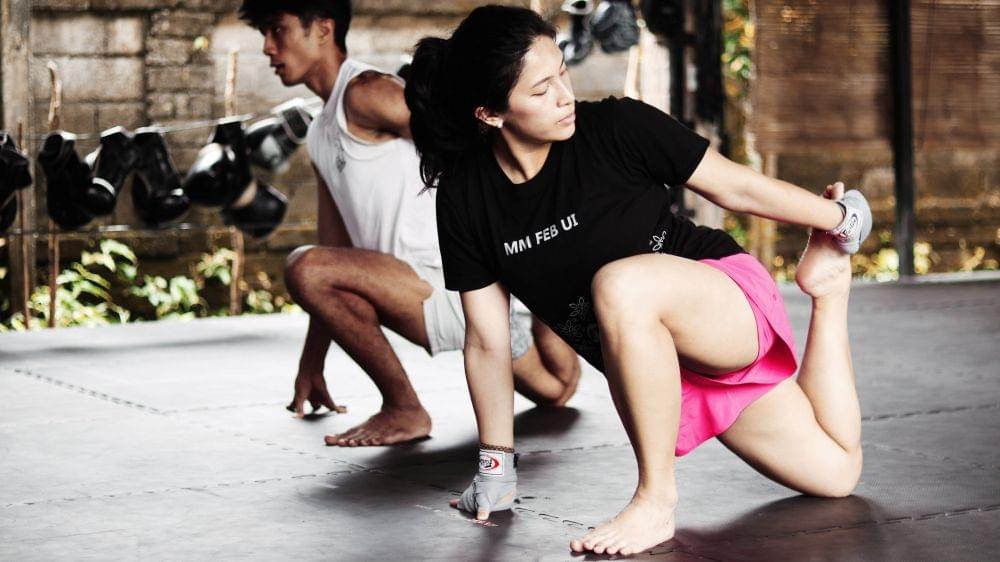Tight hips, stiff shoulders, and limited thoracic rotation these are the mobility issues that sneak up on many Muay Thai athletes, often leading to inefficient movement or nagging injuries. Fighters tend to focus heavily on striking, conditioning, and pad work, but mobility can be a missing link that holds back performance.
In this article, we’ll explore how yoga for Muay Thai can improve flexibility, reduce injury risk, and enhance overall performance. You'll also learn key poses that target mobility problems specific to fighters and how to incorporate them into your training schedule.
How Yoga Complements Fight Training
Some athletes still wonder, is yoga good for Muay Thai? The answer is a resounding yes when used strategically. Yoga improves joint mobility, muscle elasticity, and body awareness, all of which are crucial for effective striking, balance, and injury prevention.
Fighters often experience tightness in areas like the hips, hamstrings, and shoulders due to repetitive movements and high-intensity training. Over time, this tightness can limit kicking height, slow rotation on strikes, and increase vulnerability to strains. Yoga directly addresses these limitations by restoring functional movement patterns.
Beyond the physical, yoga also enhances mental focus, breath control, and stress reduction, making it one of the most holistic recovery tools available for combat athletes.
Top Yoga Poses for Muay Thai Fighters
These yoga poses directly target the mobility limitations and muscular imbalances that often develop through intense Muay Thai training. They’re simple, effective, and highly beneficial for fighters aiming to improve range, posture, and recovery.
1. Pigeon Pose
This pose is excellent for loosening up tight hips, a common issue for fighters who spend hours drilling kicks and knees. It improves hip rotation and flexibility, helping you throw cleaner high kicks and move more freely during clinch exchanges.
How to do it:
- Begin in a tabletop or downward dog position.
- Slide your right knee forward, placing it behind your right wrist.
- Extend your left leg straight back with the top of your foot resting on the floor.
- Square your hips and slowly fold forward over your right leg.
- Hold for 1–2 minutes, then switch sides.
2. Downward Dog
Downward Dog stretches out your hamstrings, calves, and shoulders while also building shoulder stability. It’s a great all-around pose for fighters feeling stiff after heavy pad sessions or long training days, and it helps rebalance posture affected by forward-leaning stances.
How to do it:
- Start in a plank position.
- Push your hips back and up to form an inverted "V" shape.
- Keep your spine long, head relaxed, and heels moving toward the floor.
- Press your hands firmly into the mat and engage your shoulders.
- Hold for 30–60 seconds while breathing deeply.
3. Lizard Pose
This pose targets your hip flexors, groin, and hamstrings, areas that can get especially tight from explosive kicks and constant movement. It’s ideal for improving range of motion in your lower body, which translates directly into stronger, more fluid strikes.
How to do it:
- Step your right foot forward into a low lunge.
- Bring both hands to the inside of your right foot.
- Lower your elbows to the floor or rest them on a block.
- Keep your left leg extended behind you.
- Sink your hips gently and hold for 30–60 seconds per side.
4. Seated Twist
Seated twists enhance spinal mobility and help improve rotational strength, key for powerful elbows, hooks, and roundhouse kicks. It also relieves tension built up through clinch work or repeated striking from one side.
How to do it:
- Sit with both legs extended forward.
- Bend your right knee and cross your right foot over your left thigh.
- Place your right hand behind you for support.
- Hook your left elbow outside your right knee.
- Twist gently from the torso, looking over your right shoulder. Hold for 30 seconds, then switch sides.
5. Shoulder Bridge Pose
Bridge pose helps strengthen your glutes and lower back while opening up your chest and hip flexors. It’s a great counterbalance to the hunched posture that can develop from hours of shadowboxing, clinching, and pad work, helping you stay upright and explosive in your movement.
How to do it:
- Lie on your back with knees bent and feet flat on the floor, hip-width apart.
- Press into your feet and lift your hips upward.
- Interlace your hands beneath your back and press your arms down.
- Engage your glutes and lift through the chest.
- Hold for 30–45 seconds with steady breathing.
When to Use Yoga in Your Training Week

Understanding how and when to add yoga to your routine is just as important as knowing the poses. Here’s how to time it effectively.
- Post-Training Recovery: Use yoga on evenings after hard sparring or pad sessions to cool down and ease muscle tightness.
- Active Rest Days: Incorporate a 30–45 minute yoga session on your off days for active recovery that restores mobility without taxing your system.
- Pre-Training Mobility Flow: A short 10–15 minute flow can help prepare your joints and muscles before a technical session, especially when training clinch, kicks, or movement drills.
Avoid long, deep static holds right before explosive training, as they may temporarily reduce power. Save those for cooldowns or recovery-focused sessions.
Join a Muay Thai class at Ubud Muay Thai and experience training that blends strength, mobility, and technique. Our experienced coaches will guide you every step of the way to help you reach your full potential in the ring and beyond.

